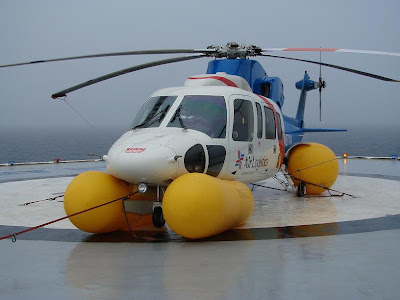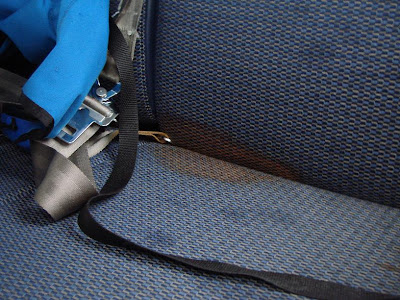Robert S. sends these pictures of a Sikorsky S-76C helicopter, which was operating in the Gulf of Mexico last month. It encountered severe weather conditions while approaching an oil rig, and a severe downdraft apparently blew it into the water (fortunately upright).
The pilots were able to deploy the floats in time, and the helicopter floated on the water for thirty seconds or so until the downdraft passed. They were then able to lift off the water and land on the oil rig’s helicopter platform. (Click the pictures for a larger view.)
The experience must have been pretty darn scary for those inside . . . as evidenced by the helicopter seats after the passengers had disembarked!
Peter




It was an obvious brown trousers moment.
Some years ago when I was doing flight ops, I always made a latrine call before a mission. We carried out up to four missions in a day and sometimes never left the A/C between missions, returning for fuel and munitions then out again.
WV: grind
Yes it was.
As Bill Cosby said…
“That’s what an accident is. First you say it…then you do it.”
*8P
They dood it alright…
Kathryn would love to know the specific platform involved, if you might know it, Peter? She shared the post with others in her office and everyone got a slef-conscious laugh as probably they also realized they might well have trouble with the pucker-factor with that situation! Kudos to the pilot!
Rova, no info on the platform, I’m afraid. You might want to check the FAA or NTSB Web sites to see whether they have any further information. Look for helicopter accidents in the Gulf of Mexico during November 2008.
A Statement from Air Logistics (from http://www.pprune.org/rotorheads/352605-gom-trio-losses-air-log-phi-era.html )
“It has come to our attention that erroneous information is being circulated concerning an aircraft event in the U.S. Gulf of Mexico involving an Air Logistics helicopter. Below are the facts related to the event.
On Friday, November 14, 2008, at 0600, an Air Logistics Sikorsky S-76C++ departed Galliano with eight passengers heading to Garden Banks 462. This drilling-rig crew change was the first of two flights scheduled that day to the same location.
The flight crew completed the required flight planning, including checking current weather and the area forecast. The forecast indicated isolated rain showers, some possibly heavy, some possible lightning and the potential for winds in the 35 knot range – in short, a typical November weather forecast for the deep Gulf of Mexico. The fuel planning was completed and the crew departed with the fuel required for the flight with an additional 45-minute reserve. Additional fuel was available on the rig if needed. The weather allowed the flight to be conducted under Visual Flight Rules (VFR). En-route altitudes were in the 1200 foot range. The flight would take approximately 1 hour and 5 minutes. The crew monitored the weather conditions en route and received flight-following reports.
Approximately five minutes prior to landing, the crew called the rig and received a “green deck” signal, indicating permission to land. The Pilot in Command (PIC) asked for and received the updated weather report from the rig. Upon arrival in the lease block, the crew encountered increasing heavy rain showers as they circled the rig to position the aircraft for a landing into the wind.
Playback of the aircraft’s Cockpit Voice Recorder (CVR) recorded the crew conducting standard callouts of airspeed and altitude, and indicated good crew coordination. After the aircraft was positioned into the wind and stabilized on approach, the PIC transferred the controls to the Second in Command (SIC), who would have the best view of the approach path into the wind. On final approach but still safely away from the structure, the aircraft encountered a severe downdraft along with an extremely heavy rain shower that forced the aircraft to descend below the level of the helideck. The SIC increased power; however, the severe downdraft continued to force the aircraft to descend.
As a precaution, the crew inflated the aircraft emergency floats. The aircraft came to a controlled hover below the level of the helideck and safely away from the structure. The aircraft’s descent was arrested within a few feet of the water. The crew never stopped flying the aircraft. This action averted a potential disaster.
With the severe downdraft subsided, the crew safely returned the aircraft to the heliport and all passengers disembarked unharmed. The data from the aircraft’s CVR and Flight Data Recorder (FDR) was secured that afternoon and returned to New Iberia for analysis. The data showed that the aircraft experienced no exceedances. The decision to bring the aircraft back by boat was due to the fact that the emergency floats had been inflated and could not be repacked at the rig. There was no visual evidence of damage to the aircraft nor at anytime did the aircraft enter the water during the event. “
That fills in the blanks!